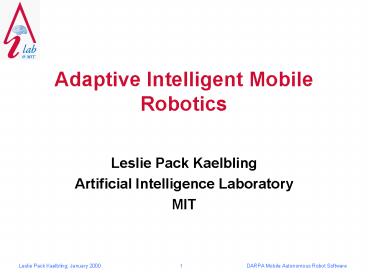Adaptive Intelligent Mobile Robotics - PowerPoint PPT Presentation
1 / 15
Title:
Adaptive Intelligent Mobile Robotics
Description:
Erik the Red. Video game environment. Optical flow implementation ... Erik the Red. RWI B21 robot. camera, sonars, laser range-finder, infrareds. 3 Linux machines ... – PowerPoint PPT presentation
Number of Views:35
Avg rating:3.0/5.0
Title: Adaptive Intelligent Mobile Robotics
1
- Adaptive Intelligent Mobile Robotics
- Leslie Pack Kaelbling
- Artificial Intelligence Laboratory
- MIT
2
Progress to Date
- Erik the Red
- Video game environment
- Optical flow implementation
- Fast bootstrapped reinforcement learning
3
Erik the Red
- RWI B21 robot
- camera, sonars, laser range-finder, infrareds
- 3 Linux machines
- ported our framework for writing debuggable code
4
Erik the Red
5
Crystal Space
- Public-domain video-game environment
- complex graphics
- other agents
- highly modifiable
6
Crystal Space
7
Optical Flow
- Get range information visually by computing
optical flow field - nearer objects cause flow of higher magnitude
- expansion pattern means youre going to hit
- rate of expansion tells you when
- elegant control laws based on center and rate of
expansion (derived from human and fly behavior)
8
Optical Flow in Crystal Space
9
Making RL Really Work
- Typical RL methods require far too much data to
be practical in an online setting. Address the
problem by - strong generalization techniques
- using human input to bootstrap
10
JAQL
- Learning a value function in a continuous state
and action space - based on locally weighted regression (fancy
version of nearest neighbor) - algorithm knows what it knows
- use meta-knowledge to be conservative about
dynamic-programming updates
11
Incorporating Human Input
- Humans can help a lot, even if they cant perform
the task very well. - Provide some initial successful trajectories
through the space - Trajectories are not used for supervised
learning, but to guide the reinforcement-learning
methods through useful parts of the space - Learn models of the dynamics of the world and of
the reward structure - Once learned models are good, use them to update
the value function and policy as well.
12
Simple Experiment
- The hill-car problem in two continuous
dimensions - Regular RL methods take thousands of trials to
learn a reasonable policy - JAQL takes 11 inefficient but eventually
successful trails generated by humans to get 80
performance - 10 more subsequent trials generate high quality
performance in the whole space
13
Success Percentage
14
Trial Length (200 max)
54-step optimum
15
Next Steps
- Implement optical-flow control algorithms on
robot - Apply RL techniques to tune parameters in control
algorithms on robot in real time - corridor following using sonar and laser
- obstacle avoidance using optical flow
- Build highly complex simulated environment
- Integrate planning and learning in multi-layer
system































